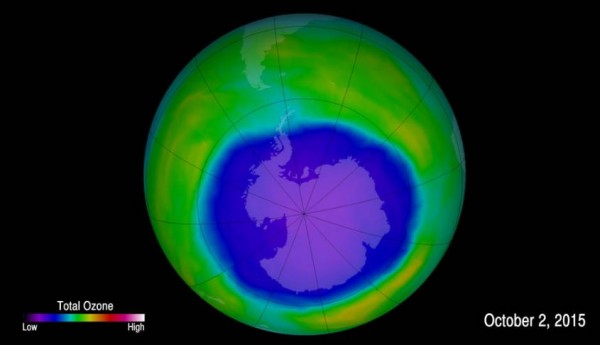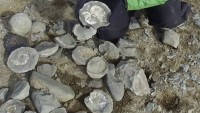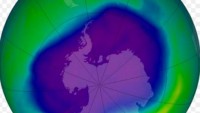Dangerous Antarctic Ozone Hole has Gotten Smaller and is Healing
| Arthur Dominic Villasanta | | Jul 03, 2016 10:58 AM EDT |
(Photo : NASA/Goddard Space Flight Center) The ozone hole above Antarctica on Oct. 2, 2015 was bigger than North America.
A new study showing the infamous and massive hole in the Antarctic ozone layer has shrunk by some 4 million square kilometers illustrate what the world can do to solve a dangerous crisis if they heed warnings made by scientists.
The ozone hole is a severe depletion of the ozone layer above Antarctica. Ozone depletion is mostly caused by man-made compounds that release chlorine and bromine gases into the stratosphere.
Like Us on Facebook
NASA and the National Oceanic and Atmospheric Administration reported the 2015 Antarctic ozone hole area was larger and formed later than in recent years. The ozone hole expanded to its peak of 28.2 million square kilometers on Oct. 2, 2015, an area larger than the continent of North America.
The new study just published in the journal Science found evidence the ozone hole or the "ozone depletion area" that increases the likelihood of skin cancer is healing and is no longer as deep as it once was. A full recovery, or closing the hole in the ozone layer, isn't expected to occur until the middle of the century, however.
Researchers led by Dr. Susan Solomon, an MIT professor of atmospheric chemistry and climate science, also found over half the reduction can be traced to a fall in atmospheric chlorine.
"We can now be confident that the things we've done have put the planet on a path to heal," said Dr. Solomon.
"Which is pretty good for us, isn't it? Aren't we amazing humans, that we did something that created a situation that we decided collectively, as a world, 'Let's get rid of these molecules'? We got rid of them, and now we're seeing the planet respond."
The major man-made source of atmospheric chlorine are chlorofluorocarbons (CFCs), which were used to propel hair sprays and generate cold in refrigerators and air conditioners.
Scientists noticed a dramatic thinning of the ozone above Antarctica in the 1980s and research proved CFCs were the main source of the damage to the ozone layer that protects the Earth from harmful ultraviolet radiation emitted by the Sun and humans from solar radiation that can damage DNA.
Using CFCs introduces chlorine into the ozone layer, increasing the atmospheric chlorine that eats away at the ozone layer.
To protect the ozone layer, practically all the nations in the world agreed to phase out the ozone-depleting substances through an international treaty known as the Montreal Protocol signed in 1987. Scientists said the gradual healing of the ozone layer is an indication the Montreal Treaty is a success.
"A chemically driven increase in polar ozone (or "healing") is expected in response to this historic agreement. Observations and model calculations taken together indicate that the onset of healing of Antarctic ozone loss has now emerged in September," said the study.
TagsOzone hole, NASA, National Oceanic and Atmospheric Administration, Dr. Susan Solomon, chlorofluorocarbons, CFCs
©2015 Chinatopix All rights reserved. Do not reproduce without permission
EDITOR'S PICKS
-

Did the Trump administration just announce plans for a trade war with ‘hostile’ China and Russia?
-

US Senate passes Taiwan travel bill slammed by China
-

As Yan Sihong’s family grieves, here are other Chinese students who went missing abroad. Some have never been found
-

Beijing blasts Western critics who ‘smear China’ with the term sharp power
-

China Envoy Seeks to Defuse Tensions With U.S. as a Trade War Brews
-

Singapore's Deputy PM Provides Bitcoin Vote of Confidence Amid China's Blanket Bans
-

China warns investors over risks in overseas virtual currency trading
-

Chinese government most trustworthy: survey
-

Kashima Antlers On Course For Back-To-Back Titles
MOST POPULAR
LATEST NEWS
Zhou Yongkang: China's Former Security Chief Sentenced to Life in Prison

China's former Chief of the Ministry of Public Security, Zhou Yongkang, has been given a life sentence after he was found guilty of abusing his office, bribery and deliberately ... Full Article
TRENDING STORY

China Pork Prices Expected to Stabilize As The Supplies Recover

Elephone P9000 Smartphone is now on Sale on Amazon India

There's a Big Chance Cliffhangers Won't Still Be Resolved When Grey's Anatomy Season 13 Returns

Supreme Court Ruled on Samsung vs Apple Dispute for Patent Infringement

Microsoft Surface Pro 5 Rumors and Release Date: What is the Latest?













